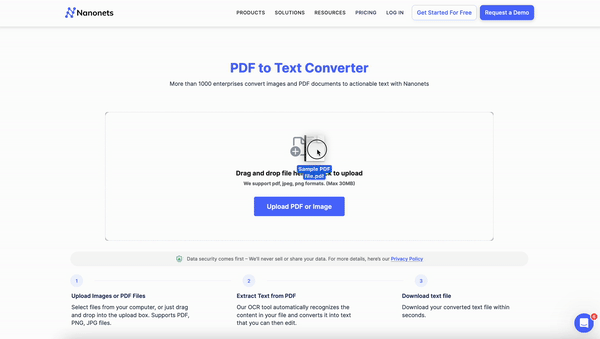
Editing scanned PDFs feels like trying to modify a photograph of a book page instead of the actual text. Because they are essentially images and cannot be directly edited or searched like regular text documents. What is the solution then?
Retyping the entire PDF in Microsoft Word may seem like an option, but let's face it — that's about as fun as watching paint dry, especially for longer documents. Life's too short for that.
Thankfully, there are better ways to tackle this problem. In this article, we'll explore eight ways to convert a scanned PDF to an editable Word document. From Acrobat Reader and Microsoft Word, mobile scanners, and online converters to AI-powered Optical Character Recognition (OCR) software, we'll list down different methods to get the job done, whether you're dealing with a simple one-page document or a lengthy multi-page report.
Scanned PDFs → Word in seconds!
Reduce up to 90% time on document processing workflows with Nanonets. Convert your image PDF files to editable text in seconds and download the file for free.
1. Use Microsoft Word's built-in tools
Microsoft Word now has a built-in feature that allows users to convert scanned PDFs or images into editable Word documents directly within the application.
To use this feature, simply open a scanned PDF or image in Word, and the program will prompt you to convert the file using its built-in OCR.
Benefits:
- The workflow is straightforward
- No additional software installation required
Challenges:
- Limited control over OCR settings and output options
- It may not be as accurate as dedicated OCR software, especially for complex layouts or poor-quality scans
- Batch processing is not possible
2. Export PDF files to Word with Adobe Acrobat Reader
Adobe Acrobat Reader Pro, the popular PDF viewer, includes a PDF-to-Word conversion feature that allows users to export scanned PDFs as editable Word documents.
To access the feature, open your scanned PDF in Adobe Acrobat Reader Pro, click on "Export a PDF" from "All Tools", and select DOCX as the export format.
Benefits:
- Seamless integration with the Adobe ecosystem
- Familiar interface for Adobe users
Challenges:
- You must be an Acrobat Pro subscriber to access the feature and the subscription is priced at US$19.99/mo.
- Limited control over OCR settings and output options compared to dedicated OCR software
- Batch processing is not possible without additional automation

Extract data from scanned PDFs to any app!
Export extracted data to 5000+ apps via Zapier, API, or webhooks for a seamless workflow. Send structured data from scanned PDFs to your accounting software, ERPs, and CRMs with automated workflows.
3. Use AI-powered OCR software to convert scanned PDFs
OCR (Optical Character Recognition) technology converts scanned documents into editable files. It works by scanning the document, enhancing the image quality, recognizing the text using pattern recognition algorithms, and generating an editable output file. OCR eliminates manual data entry, reduces errors, processes documents in multiple languages, and enables businesses to digitize and centralize their document management efficiently.
AI-powered OCR, like Nanonets, takes it further by leveraging machine learning to efficiently handle complex documents, deliver highly accurate results, and extract valuable insights.
Automate scanned PDFs-to-Word workflow with Nanonets
With its intelligent algorithms and AI-powered OCR, Nanonets can handle anything from simple contracts to complex invoices and receipts. You can accurately extract text, tables, and key-value pairs from these documents, and convert the data into structured formats for further analysis.
For starters, Nanonets offers a free tool that converts scanned PDFs to editable documents using AI-powered OCR.
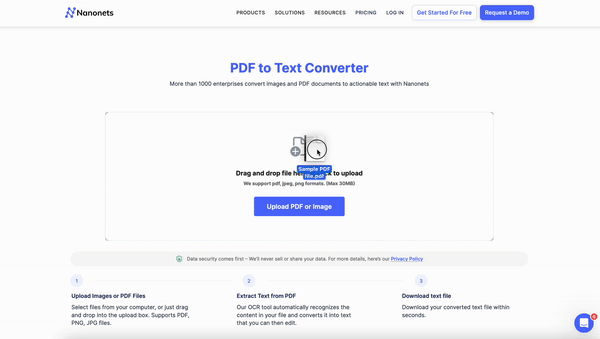
Here's how to use it:
- Go to Nanonets PDF to Word Converter.
- Upload your file or drag and drop it into the tool.
- Now, you can download your text file easily.
For more advanced extraction needs—think documents with complicated layouts, unstructured data, or multiple languages—Nanonets' advanced document OCR is your go-to solution. It allows you to process hundreds of scanned PDF files, converting them to editable Word files in one go or as they're automatically uploaded to cloud storage or email.
But here's where it gets even better: You can train custom OCR models to automatically capture critical information like invoice numbers, dates, addresses, or line items from your documents. This helps reduce manual data entry, saving you from countless hours of joyless work.
Nanonets goes beyond just data extraction, though. It enables you to automate your entire document processing pipeline, from capture and classification to validation and data export. And with its seamless integrations with popular tools like Zapier, you can quickly set up workflows to automatically export the extracted data to Google Docs, MS Excel, Dropbox, or your ERP system. No more tab hopping or mind-numbing copy-paste routines.
Here's a quick overview to help you get started:
Step 1: Visit app.nanonets.com, enter your email to get started or sign up using a Gmail account
Step 2: Choose your approach
Create a custom model for you unique scanned PDF workflows
- Pre-trained OCR models: invoices, receipts, tables, Bill of Lading, etc.
- Custom OCR model: for unique scanned PDF workflows or distinctive layouts
Step 3: Import scanned PDFs
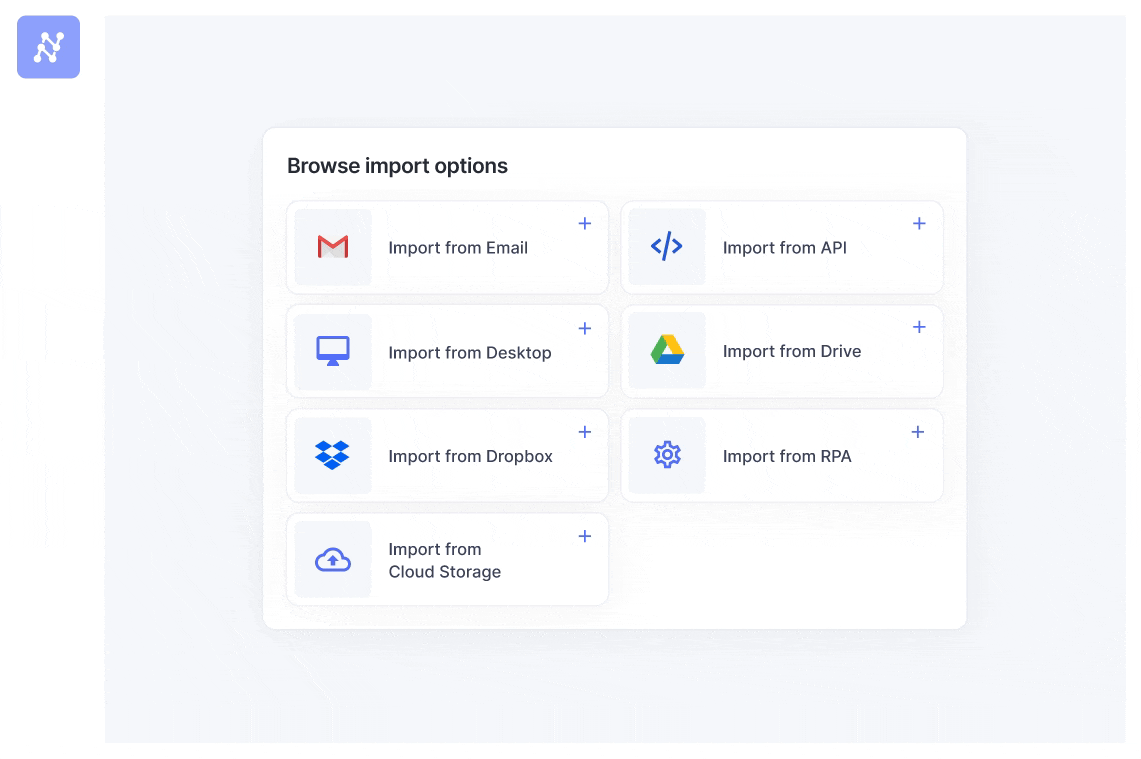
- Web upload: drag and drop or click "Add files"
- Email: set up auto-forwarding to your Nanonets address
- Google Drive: connect account, select folder, auto-import new files
- Zapier: connect with 5,000+ apps, automate import from various sources
- API: programmatically send PDFs for conversion
Step 4: OCR processing and validation
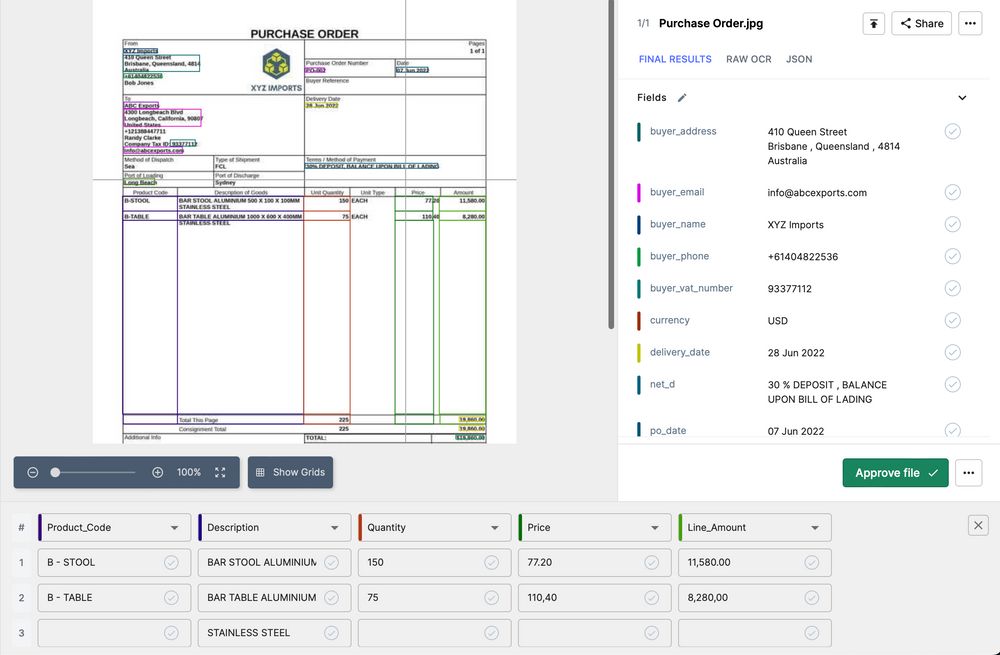
- AI-powered OCR extracts text, tables, and elements
- Review and validate extracted data
- Define rules to flag invalid or inconsistent data
- Enhance and enrich extracted information

Step 5: Export extracted text
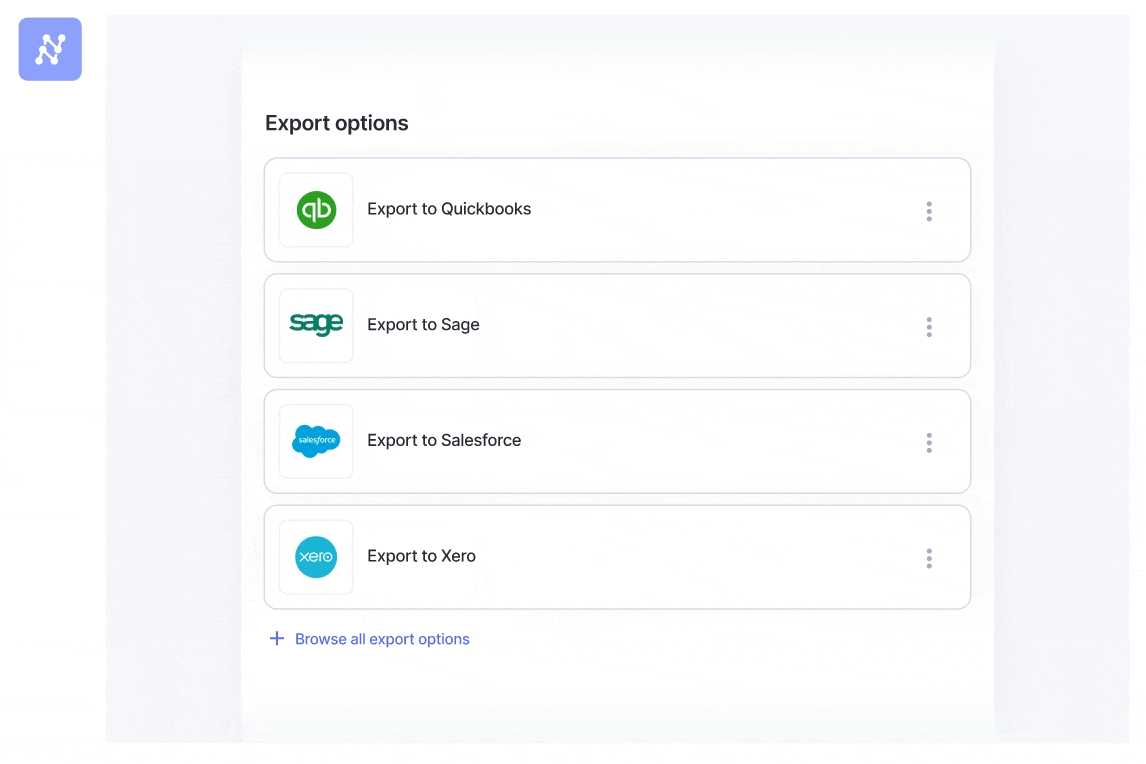
- Download directly to your computer
- Export to Google Docs: integrate extracted data, create new documents
- API: retrieve converted data programmatically
- Cloud storage: export to Google Drive, Dropbox, or OneDrive
- Third-party apps: automate workflows using Zapier integration

Scan, edit, integrate — easy!
Process thousands of scanned files in bulk, saving time and effort compared to desktop software. Try it for free!
4. Convert scanned PDFs to Word using a desktop OCR software
Desktop OCR software programs are installed directly on your computer, offering more control over the conversion process and output settings. These tools often include advanced features like batch processing, document editing, and support for multiple languages.
Top examples of desktop OCR software include:
- ABBYY FineReader
- FileCenter
- Readiris
- PaperScan Scanner
Benefits:
- More control over the OCR process and output settings
- Can handle large volumes of documents offline
- Often includes advanced features like batch processing and document editing
Challenges:
- More expensive than online solutions
- Steeper learning curve
- Requires installation and is limited to the computer on which it's installed
5. Capture and convert documents using mobile OCR apps
Due to the improvement in mobile cameras and processing power, mobile OCR apps have become increasingly popular for on-the-go document scanning and conversion. These apps allow users to capture images of documents using their smartphone cameras and convert them into editable text or Word documents.
Top examples of mobile OCR apps include:
- Adobe Scan
- Office Lens
- CamScanner
Benefits:
- Convenient and accessible
- Often free or more affordable than desktop software
- Integrates with cloud storage for easy sharing and collaboration
Challenges:
- It may not be as accurate as desktop software, especially for complex layouts or poor-quality scans
- Limited control over OCR settings and output options
- Not suitable for large volumes of documents due to mobile device storage constraints
6. Upload the document to online OCR tools
Online OCR tools are web-based services that allow you to convert scanned PDFs to Word without installing software. They are accessible from any device with an internet connection and are often free.
Top examples of online OCR tools include:
- OnlineOCR.net
- SmallPDF
- OCR Space
Benefits:
- Accessible from any device with an internet connection
- Often free or more affordable than desktop software
- Ideal for occasional or one-off conversions
Challenges:
- Requires an internet connection to function
- May have file size or page count limitations
- Privacy concerns, as documents are uploaded to third-party servers for processing
- Less control over OCR settings and output compared to desktop software
7. Use an open-source OCR tool
Open-source OCR tools are freely available software that allows users to access and modify the source code. These tools are often developed and maintained by a community of developers, offering transparency and flexibility. Some open-source OCR tools, such as OCRmyPDF, are built using Python libraries like Tesseract. If you want to use Python for OCR, check out the Python libraries section below.
Top examples of open-source OCR tools include:
- GOCR
- CuneiForm
- docTR
- Ocrad
Benefits:
- Free to use and modify
- Transparent and flexible
Challenges:
- Steeper learning curve
- It may require more technical knowledge to set up and use effectively
- It may lack user-friendly interfaces and documentation

Say goodbye to complex scanned document editing workflows.
Extract a scanned PDF file and export the text into an editable Word document from any web browser with Nanonets. No coding required - just upload, convert, and edit with ease. Try it free today and streamline your document workflow!✨
8. Deploy Python libraries for OCR
Python offers several libraries for OCR and document processing. These libraries allow developers to build custom OCR solutions and integrate them into their applications or workflows. Python libraries can be used to create custom OCR solutions or integrate OCR capabilities into other applications. Many open-source OCR tools covered in the previous section are also built using these libraries.
Top examples of Python libraries for OCR include:
- PyTesseract
- OCRmyPDF
Benefits:
- Allows for custom OCR solutions and integration with other tools
- Can be automated and scaled for large volumes of documents
- Offers flexibility and control over the OCR process
Challenges:
- Requires programming skills and technical knowledge
- It may have a steeper learning curve for non-technical users
- Requires setting up a development environment and managing dependencies
When choosing an alternative method for converting scanned PDFs to Word, evaluating your specific needs and considering factors such as accuracy, document complexity, batch processing requirements, and customization options is essential. While these alternatives can be helpful in certain situations, they may have limitations compared to AI-powered OCR solutions like Nanonets.
Tips and tricks to achieve optimal OCR results
Nobody wants to spend hours and hours manually editing and formatting converted documents. To ensure the best possible results when converting scanned PDFs to Word, consider the following tips and tricks:
Scanning stage
- Use a high-quality scanner with a resolution of at least 300 DPI for text-based documents and 600 DPI for documents with images or complex layouts.
- Ensure the scanner glass is clean and free from smudges or dirt to avoid image quality issues.
- Align the document properly on the scanner bed to prevent skewed or crooked scans.
- Use the scanner's automatic document feeder (ADF) for multi-page documents to save time and ensure consistent alignment.
- Scan in grayscale or black and white for text-based documents to reduce file size. Use color only when necessary.
- Enable blank page detection to remove any empty pages from the scanned document.
- Use a scanning app with built-in image enhancement features, such as Office Lens or Adobe Scan, to automatically optimize the scanned image for better OCR results. These apps can correct perspective, adjust contrast, and remove shadows, making the conversion process smoother.
Pre-processing stage
- Organize and prepare the documents before scanning. Remove staples, paperclips, or sticky notes that may obstruct the text or cause scanning issues.
- If you need to scan old, fragile documents or photographs, consider using a flatbed scanner with a high resolution (600 DPI or more). Place the document on the scanner glass carefully and use a soft, lint-free cloth to smooth out any creases or folds gently.
- Use a contrasting background, such as a white sheet of paper, behind the document to help the scanner detect the edges accurately.
- For delicate or fragile documents, consider using a flatbed scanner instead of an ADF to minimize the risk of damage.
OCR and conversion stage
- Set up automated ingestion workflow to ensure consistent and efficient processing of large volumes of documents.
- Choose an OCR solution with high accuracy rates and support for multiple languages, such as Nanonets.
- Ensure the scanned document is of sufficient quality and resolution for accurate OCR results.
- Select the appropriate output format (e.g., .docx) and OCR settings (e.g., layout retention, language) based on your requirements.
- Verify the converted text and make necessary corrections using the OCR software's built-in editing tools.
Post-processing and export stage
- Review the converted Word document for any formatting inconsistencies or recognition errors.
- Adjust the document's layout, fonts, and styles to match your preferences or corporate branding guidelines.
- Use the built-in spell checker and grammar tools in Word to identify and correct any remaining errors.
- Save the final document in the desired format (e.g., .docx, .pdf) and optimize the file size for storage or sharing.
- Implement a consistent file naming convention and organize the converted documents in a logical folder structure for easy retrieval. For example, a financial institution could organize converted Word files by client name, document type, and date (e.g., "ClientX_TaxReturn_2023-04-15.docx").
- Use Zapier integrations to send the converted Word documents directly to your preferred business systems for further processing.
Why use Nanonets to OCR scanned PDF to Word?
Nanonets stands out as an AI-powered OCR software , offering a unique and comprehensive solution for converting scanned PDFs to editable Word documents with an impressive 98%+ accuracy. Its intuitive user interface and swift setup process (completed in under 15 minutes) make it a top choice for businesses and individuals seeking to streamline their document workflows.
With Nanonets, you can:
- Process large PDF files instantly by batch processing hundreds of PDFs simultaneously, saving hours of manual work.
- Extract text from scanned PDFs, including handwritten content and numbers, easily.
- Convert OCR PDF to Word format, making it a reliable OCR PDF to Word converter.
- Extract data and text from scanned PDFs in over 40+ languages, thanks to its multi-language support.

Dealing with a large volume of scanned files?
No problem! Nanonets' powerful OCR can handle bulk processing with ease, accurately extracting data from hundreds or even thousands of documents in a matter of minutes. Skip all the manual data entry and boost your productivity!
Nanonets: A versatile enterprise PDF processing platform
Get fully customizable solutions for enterprises looking to convert scanned PDF to Word documents on a large scale. As an online OCR software, Nanonets allows you to access all its features directly from your browser without downloading.
In addition to converting scanned PDFs to Word, Nanonets can automate various manual PDF processes, such as:
- PDF data extraction
- Viewing, editing, or removing PDF metadata
- Document archiving
- Document approvals
- Merging, splitting, or rearranging PDF pages
- Zonal OCR and converting handwritten documents to text
Nanonets is the perfect solution for businesses of all sizes looking to optimize their document processes, offering:
- 1-day setup and free migration assistance
- Free trial and 24/7 support
- No-code intelligent automation
- Dedicated customer success managers
- Cloud and on-premise hosting options
- SOC2 and GDPR compliance
- Automated audit trails
- Automated payment platforms
- Integrations with over 5,000 applications
- Support for 200+ languages
- No post-processing required
Is Nanonets PDF to Word free to use?
Yes, Nanonets offers a free PDF to Word-conversion service. You can extract data from scanned PDFs, including barcodes, handwritten text, tables, and metadata, at no cost. By creating a free account, you can also access no-code workflows to automate repetitive tasks such as document upload, pre-processing, and data entry.
During your free trial, Nanonets also allows you to extract data from other types of documents, such as images, emails, invoices, and receipts.
If you have any questions or require a customized solution for converting scanned PDFs to Word documents on a large scale, feel free to reach out to the Nanonets team.
Final thoughts
Converting scanned PDFs to editable Word documents doesn't have to be a hassle. Whether you're dealing with invoices, contracts, or any other type of scanned document, embracing the right tools and techniques can significantly improve your productivity and streamline your workflow.
If you want to automate your document conversion process on a larger scale, consider using an AI-powered platform like Nanonets. With features like bulk document conversion, advanced OCR technology, and seamless integrations, Nanonets can help you efficiently convert scanned PDFs to editable formats while maintaining the original layout and formatting.
Read more:
- How to convert PDF images to text?
- How to convert scanned PDF to word online for free?
- How to convert PDF to word?
- How to convert PDF to word on Mac?
Scanned PDF to Word workflow FAQs
How do I convert a scanned PDF to editable?
You can use Nanonets PDF to word tool to make your scanned PDFs editable in 4 steps. Open Nanonets PDF to Word tool > Upload your files> Click Convert> Download your text file.
Can I convert scanned PDF to Word?
Yes, you can convert scanned PDF to word using Nanonets PDF to text tool. Simply open Nanonets PDF to text tool> Upload your PDF file> Click Convert and Download your text file. Nanonets will convert your PDF into editable text format in seconds.
How can I extract text from a scanned PDF?
You can use OCR software, like Nanonets, to convert text from a scanned PDF into text format that can be edited easily. Simple use Nanonets PDF to text converter tool. Upload your scanned PDF to convert it into text. It also converts handwritten text into editable digital text.
How do I convert a scanned document to text?
Using an online PDF-to-text OCR tool, you can convert a scanned document to text. Online OCR tools, like Nanonets PDF to text can convert scanned PDFs containing text or handwritten text into txt format.
Can I convert a scanned PDF to Word without losing formatting?
Yes, Nanonets' AI-powered scanned PDF-to-Word converter is designed to preserve the original formatting of your scanned document. It ensures that your document's layout, structure, and appearance remain intact during the conversion process.
Is there an AI-powered scanned PDF-to-Word converter?
Yes, Nanonets is an AI-powered scanned PDF-to-Word converter. It leverages advanced machine learning algorithms to accurately recognize and extract text from scanned PDFs, making the conversion process more efficient and precise than traditional OCR methods.








